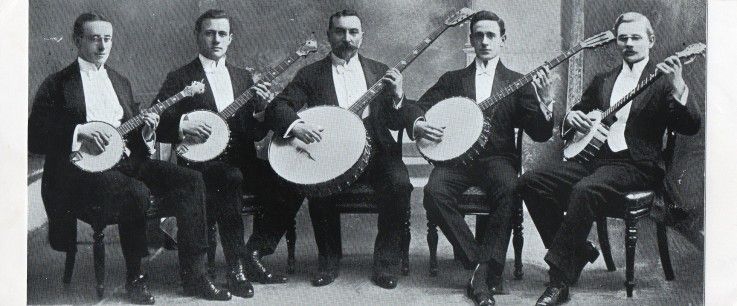Classic Ragtime Banjo in Brooklyn
Classic “finger style” five-string banjo is one American music instrumental style that really is close from total extinction. It’s ironic - at one time it was probably one of the most popular styles in the country towards the end of the 19th century.
Virtuoso players like Vess Ossman and Fred Van Epps were pop stars of their time, cutting cylinders and 78s that were found in living rooms across the country. “Banjo orchestras” were in every town, university, and social club. Thousands of pieces of sheet music were issued specifically for the banjo. It was America’s favorite instrument and instrumental style, and the craze hit England by the end of the 19th century.
Typical banjo orchestra
Classic banjo was almost always a gut string banjo with at least 5 strings, played much like classic guitar with the bare fingers (no picks). The music was complicated, syncopated, and full of intriguing melodic twists and turns so characteristic of the ragtime compositions of the era (think Scott Joplin if you are scratching your head).
But when the plectrum banjo entered the scene in the early 20th century, classic banjo “had its ass kicked” by its louder, sharper, and picked 4 string cousin, to quote Georgia ragtime genius Mick Kinney. Slowly the style began to disappear, although not before heavily influencing bluegrass banjo on its way out.
Today only a few practitioners exist, including the American Banjo Fraternity which maintains classic banjo as a living tradition - many of the members learned directly from folks who learned directly from the banjo greats of the early 20th century. But it remains an arcane banjo art (and its damn hard to play as well). While bluegrass, dixieland, and old time banjo styles are alive and well, this one funky style is only kept alive by a devoted band of semi-lunatics (including myself).
A real living tradition!
I’ve been in love with classic banjo since getting a dropbox full of sheet music from an English classic banjo player in 2014. When I moved to New York in 2015 I was lucky to find myself in the presence of one of the most feted living classic banjo players in the US: Clarke Buehling. It was a chance encounter during the Brooklyn Folk Festival, which is run by the amazing folks at the Jalopy Theater and School of Music in Red Hook, Brooklyn.
The real fun at the Brooklyn Folk Festival happens in and around Jalopy many hours after the last act at the festival ends. I caught Clarke in the wee hours in one of the apartments upstairs from Jalopy jamming with another American folk musical great, Tom Marion. It was a scene from a Robert Crumb comic book: The Red Hook street lights bathed the old timey apartment with a strange yellow glow. Two old time musicians who haven’t had a tune together for ages sat among the banjos and 78 records trading classic banjo tunes. Clarke flawlessly picking out the complicated classic banjo tunes while Tom Marion.
The tune above is “St Louis Tickle” written in 1904 by Theron C. Bennett.
On guitar, Tom Marion is a legend in his own right. According to a website for one of his many projects in California:
He is the last of the old-time Italian string players. He plays guitar, banjo and mandolin with equal grace, and in a style that virtually
disappeared before World War II.Born in San Jose, California in 1949, Tom grew up in the "Little Italy" section of town. His grandfather, a Sicilian immigrant fisherman, played guitar and sang, and gave 5-year-old Tom his first lessons. He would take the boy to Tom Marotta's barber shop on cannery row, where the old musicians
hung out. Some of these players, such as Henry Ansaldo (who taught Tom mandolin), remained friends for life, infusing him with a deep respect and understanding of the old musical ways. By age ten, Tom was good enough to play his first professional gig, substituting for another guitarist. He was
paid a plate of spaghetti.

